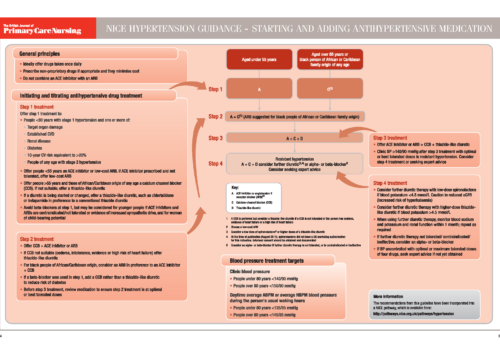This second article focuses on safe and effective prescribing of medications which will reduce risk of further cardiovascular events. This series provides a ‘hands on’ practical guide to conducting medication reviews of long-term cardiovascular conditions. In this issue, we look at how to ensure post-myocardial infarction patients are taking the right medications at the right doses to ensure they get maximum benefit.
How to carry out an annual review for patients at high CVD risk
Putting Prevention First, the national strategy for cardiovascular risk assessment for people aged 40 to 74 years, remains high on the healthcare agenda regardless of NHS changes. The “Cog Man” on the cover of the guidance and leaflets distributed to practices and pharmacies highlights the close links between the heart, brain, kidneys and diabetes and underlines the comprehensive nature of vascular risk assessment. In this article, we look at how to carry out an annual review in high-risk people with a cardiovascular risk score of 20% or higher but who do not have high blood pressure, diabetes, chronic kidney disease or atrial fibrillation.
Caring for patients with anaemia of chronic disease
Many patients presenting in general practice will, at some time, complain of tiredness and lack of energy. Investigations to discover the cause are often conducted and will usually include blood tests such as a full blood count to see if anaemia is to blame. Patients may assume that all anaemia is iron deficiency anaemia but there are, of course, different types of anaemia. Interpreting investigations correctly and acting on them appropriately can ensure that the patient gets the right diagnosis and appropriate treatment.
Back to Basics: NICE hypertension guidance – starting and adding antihypertensive medication
A practical guide to oral glucose-lowering therapies for type 2 diabetes
Effective management of type 2 diabetes requires tight control of blood glucose levels to prevent long-term complications. Recently a number of new oral therapies have become available to help patients achieve this goal. This article provides information on how each agent works, how these different agents may be used, and the side-effects to look out for.
Looking beneath the surface: the ‘no tears’ approach to medication reviews
Ten per cent of the annual NHS budget is spent on medication, with about 75% of this is prescribed in primary care. Ensuring that this money really improves patients’ health is vitally important. As the population ages, more people require increasing numbers of medications for chronic conditions and a third of elderly patients are taking four drugs or more for a spectrum of conditions. But this creates a major challenge – as research reveals that fewer than half of these patients take their medicines as prescribed. How can this challenge be addressed? This new series will provide simple practical guidance on how to conduct an effective medication review for a spectrum of long-term cardiovascular conditions.
It’s as easy as ACD: optimising hypertension treatment
The recent guideline from the National Institute for Health and Clinical Excellence (NICE) on the clinical management of primary hypertension enables us to provide evidence-based care to patients with high blood pressure (BP). The guideline provides a clear treatment algorithm, starting with A (an ACE inhibitor or angiotensin 2 receptor blocker) or C (a calcium channel blocker), depending on the age of the patient, then combining them if target BP is not reached and then adding in D (a diuretic) if required. This article uses a series of case studies to illustrate diagnosis and treatment based on the new guidelines.
Making sense of salt and cardiovascular risk
While salt is an essential part of a healthy diet excessive salt intake is now an important focus for reducing the risk of cardiovascular disease in the UK. It is estimated that reducing everyone’s salt intake to the equivalent of one teaspoon per day would prevent 23,000 deaths from stroke and heart attack each year. Here are practical ideas for helping to achive this goal.
Taking the weight: a primary care team approach to obesity management
Most of the UK population – including the patients we see every day – are now more likely to have a weight problem than be of a healthy weight. Instead of focusing our efforts, and valuable resources, on managing the consequences of obesity, we should tackle its causes and appropriately manage patients motivated to address their unhealthy weight.
In focus: Sight problems after a stroke
Following a stroke up to 60% of people have sight problems, including loss of visual field and trouble with visual processing when the brain no longer makes sense of what the eye sees. Changes to vision can also be a sign of stroke or transient ischaemic attack (TIA). The awareness of visual problems in stroke patients is highlighted in this article which explains the different sight problems and outlines steps which can be taken to help.
PCOS or overweight? Solving the diagnostic dilemma
Polycystic ovary syndrome (PCOS) is the commonest endocrinopathy, affecting 5-12% of women. Every aspect has been controversial from its nomenclature to its management. But accurate diagnosis based on consensus guidelines ensures that treatment can be tailored effectively to each woman’s symptoms and needs.
Editorial
The start of a new year is always a good time to look forward to where we hope to go; but it is also to reflect on where we have come from. While the NHS has made massive improvements in the quality of life and outcomes of our patients. Our aspirations are even higher. Our objective over the coming year is to ensure that BJPCN gives you the information and inspiration to meet these challenges and to reach for even greater heights.























